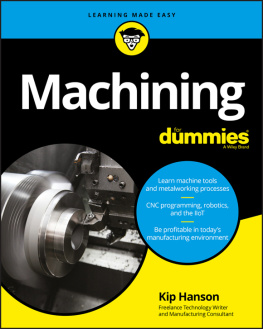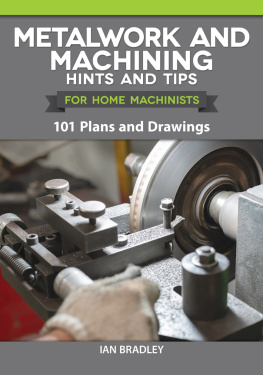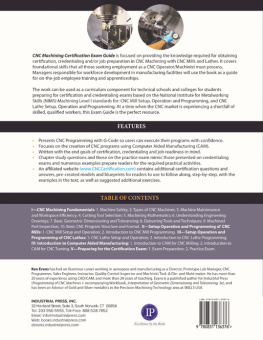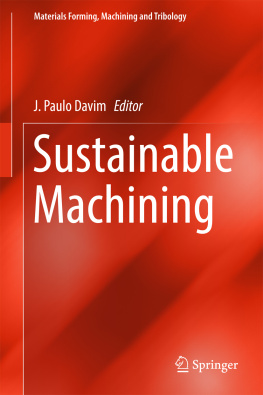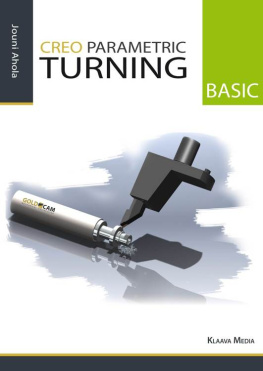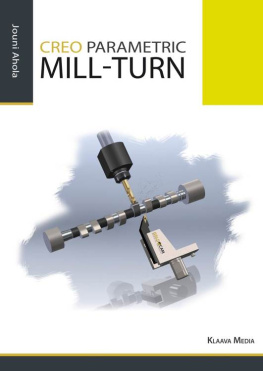

Machining For Dummies
Published by: John Wiley & Sons, Inc., 111 River Street, Hoboken, NJ 07030-5774, www.wiley.com
Copyright 2018 by John Wiley & Sons, Inc., Hoboken, New Jersey
Published simultaneously in Canada
No part of this publication may be reproduced, stored in a retrieval system or transmitted in any form or by any means, electronic, mechanical, photocopying, recording, scanning or otherwise, except as permitted under Sections 107 or 108 of the 1976 United States Copyright Act, without the prior written permission of the Publisher. Requests to the Publisher for permission should be addressed to the Permissions Department, John Wiley & Sons, Inc., 111 River Street, Hoboken, NJ 07030, (201) 748-6011, fax (201) 748-6008, or online at http://www.wiley.com/go/permissions .
Trademarks: Wiley, For Dummies, the Dummies Man logo, Dummies.com, Making Everything Easier, and related trade dress are trademarks or registered trademarks of John Wiley & Sons, Inc. and may not be used without written permission. All other trademarks are the property of their respective owners. John Wiley & Sons, Inc. is not associated with any product or vendor mentioned in this book.
LIMIT OF LIABILITY/DISCLAIMER OF WARRANTY: THE PUBLISHER AND THE AUTHOR MAKE NO REPRESENTATIONS OR WARRANTIES WITH RESPECT TO THE ACCURACY OR COMPLETENESS OF THE CONTENTS OF THIS WORK AND SPECIFICALLY DISCLAIM ALL WARRANTIES, INCLUDING WITHOUT LIMITATION WARRANTIES OF FITNESS FOR A PARTICULAR PURPOSE. NO WARRANTY MAY BE CREATED OR EXTENDED BY SALES OR PROMOTIONAL MATERIALS. THE ADVICE AND STRATEGIES CONTAINED HEREIN MAY NOT BE SUITABLE FOR EVERY SITUATION. THIS WORK IS SOLD WITH THE UNDERSTANDING THAT THE PUBLISHER IS NOT ENGAGED IN RENDERING LEGAL, ACCOUNTING, OR OTHER PROFESSIONAL SERVICES. IF PROFESSIONAL ASSISTANCE IS REQUIRED, THE SERVICES OF A COMPETENT PROFESSIONAL PERSON SHOULD BE SOUGHT. NEITHER THE PUBLISHER NOR THE AUTHOR SHALL BE LIABLE FOR DAMAGES ARISING HEREFROM. THE FACT THAT AN ORGANIZATION OR WEBSITE IS REFERRED TO IN THIS WORK AS A CITATION AND/OR A POTENTIAL SOURCE OF FURTHER INFORMATION DOES NOT MEAN THAT THE AUTHOR OR THE PUBLISHER ENDORSES THE INFORMATION THE ORGANIZATION OR WEBSITE MAY PROVIDE OR RECOMMENDATIONS IT MAY MAKE. FURTHER, READERS SHOULD BE AWARE THAT INTERNET WEBSITES LISTED IN THIS WORK MAY HAVE CHANGED OR DISAPPEARED BETWEEN WHEN THIS WORK WAS WRITTEN AND WHEN IT IS READ.
For general information on our other products and services, please contact our Customer Care Department within the U.S. at 877-762-2974, outside the U.S. at 317-572-3993, or fax 317-572-4002. For technical support, please visit https://hub.wiley.com/community/support/dummies .
Wiley publishes in a variety of print and electronic formats and by print-on-demand. Some material included with standard print versions of this book may not be included in e-books or in print-on-demand. If this book refers to media such as a CD or DVD that is not included in the version you purchased, you may download this material at http://booksupport.wiley.com . For more information about Wiley products, visit www.wiley.com .
Library of Congress Control Number: 2017955613
ISBN 978-1-119-42613-4 (pbk); ISBN 978-1-119-42649-3 (ebk); ISBN 978-1-119-42650-9 (ebk)
Machining For Dummies
To view this book's Cheat Sheet, simply go to www.dummies.com and search for Machining For Dummies Cheat Sheet in the Search box.
Table of Contents
Guide
Pages
Introduction
Since the day some clever Homo sapiens first used a rock to sharpen a tree branch, thus avoiding being eaten by a prehistoric pack of dingoes, humans have been making things. Starting with wood and stone tools, mankinds urge to manufacture would eventually lead to the invention of the wheel, agriculture and architecture, and unfortunately organized warfare.
Along the way, we figured out how to smelt and cast metals such as bronze and iron. We built printing presses, textile looms, mechanical clocks, and adding machines. But it wasnt until the development of steel and then metal-cutting machinery, however, that modern manufacturing quite literally picked up steam.
Without metal cutting, now known as machining, wed still be stuck in the horse-drawn days. It is quite literally the foundation upon which the Industrial Revolution was founded. Mechanization would have been impossible without precisely machined components, and without mechanization, there would be no factories, steamboats, locomotives, automobiles, or airplanes.
Today were facing the start of another industrial revolution. Modern metal-cutting machinery isnt responsible for it, although it can certainly take credit for getting us here. No, the next industrial revolution is digital. Its tools are data and computers and high-speed global networks, and like the other industrial revolutions, it too will change everything.
What does all that have to do with this book? Plenty. Machining and other forms of manufacturing technology may be small players in the current race toward mobility and global connectedness, but theyve definitely been invited to the party. In fact, you can talk all you like about the importance of Big Data and the Internet of Things, but without machining, none of it would be possible. Nor would modern transportation. Planes wouldnt fly; ships would sink; cars and trucks would do naught but sit on the side of the road without the machined parts to drive them.
How about all the other things that make our daily lives comfortable? The appliances that keep our food cold and make our clothes clean? Take away machining and those devices couldnt be built. If you like watching movies, youd better plan on going to the theater (the kind with live actors and performed by candlelight) in a postmachining world, because DVD players and 65-inch flat-screen TVs wouldnt exist.
And medicine? Forget it. Grandma would have to limp around without that new hip implant she was hoping for because thered be no machined prosthetics, never mind CAT scans, X-rays, prescription drugs, or surgical equipment. Cancer and other diseases would have their way with us, and a simple gallbladder surgery might prove fatal.
Food and energy production, construction of housing and infrastructure, and just about every consumer product imaginable I could go on all day about the technologies made possible by machining, but you probably get the idea. Simply put, machining brings a richness to our lives that few of us appreciate.
Enough said. Whether youre a curious consumer, a would-be hobbyist, or are (I hope) thinking about a career in manufacturing or just starting one, this book is intended to help make you just a little more knowledgeable on this important subject.
About This Book
If you read the front cover, you dont need me to tell you, but here it is: This book is about machining. Whats that? you say. Simply put, machining is the act of transforming metal, plastic, and other materials into precision components used in all the industries just mentioned.
Its a complex process, which is why Machining For Dummies is broken up into bite-sized pieces. It begins with a little bit of history (because if youre like me, you slept through that class in school), then segues smoothly into tools: machine tools, cutting tools, and tools for holding workpieces (appropriately called
Next page
